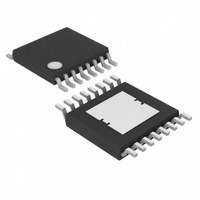MAX5068AAUE+T Maxim Integrated Products, MAX5068AAUE+T Datasheet - Page 12

MAX5068AAUE+T
Manufacturer Part Number
MAX5068AAUE+T
Description
IC CNTRLR PWM CRNT MD 16TSSOP
Manufacturer
Maxim Integrated Products
Datasheet
1.MAX5068FAUE.pdf
(20 pages)
Specifications of MAX5068AAUE+T
Pwm Type
Current Mode
Number Of Outputs
1
Frequency - Max
1.25MHz
Duty Cycle
50%
Voltage - Supply
10.8 V ~ 24 V
Buck
No
Boost
No
Flyback
Yes
Inverting
No
Doubler
No
Divider
No
Cuk
No
Isolated
Yes
Operating Temperature
-40°C ~ 125°C
Package / Case
16-TSSOP Exposed Pad, 16-eTSSOP, 16-HTSSOP
Frequency-max
1.25MHz
Duty Cycle (max)
50 %
Output Current
1000 mA
Mounting Style
SMD/SMT
Switching Frequency
25 KHz to 1250 KHz
Maximum Operating Temperature
+ 125 C
Minimum Operating Temperature
- 40 C
Synchronous Pin
Yes
Topology
Flyback, Forward
Lead Free Status / RoHS Status
Lead free / RoHS Compliant
During startup, the UVLO circuit keeps the PWM com-
parator, ILIM comparator, oscillator, and output driver
shut down to reduce current consumption. Once V
reaches 23.6V, the UVLO circuit turns on both the PWM
and ILIM comparators, as well as the oscillator, and
allows the output driver to switch. When V
below 9.7V, the UVLO circuit shuts down the PWM
comparator, ILIM comparator, oscillator, and output dri-
ver returning the MAX5068A/C/D to the startup mode.
Normally, V
transformer. However, at startup there is no energy
delivered through the transformer, hence, a special
bootstrap sequence is required.
voltages on V
V
C1 charges through the startup resistor, R1, to an inter-
mediate voltage (see Figure 1). At this point, the inter-
nal regulator begins charging C3 (see Figure 5). Only
47µA of the current supplied by R1 is used by the
MAX5068A/C/D. The remaining input current charges
C1 and C3. The charging of C3 stops when the V
voltage reaches approximately 9.5V. The voltage
across C1 continues rising until it reaches the wake-up
level of 23.6V. Once V
threshold, NDRV begins switching the MOSFET and
energy is transferred to the secondary and tertiary out-
puts. If the voltage on the tertiary output builds to high-
er than 9.74V (the bootstrap UVLO lower threshold),
startup ends and sustained operation commences.
If V
device goes back to low-current UVLO. If this occurs,
increase the value of C1 to store enough energy to
allow for the voltage at the tertiary winding to build up.
The V
diately after wakeup (see Figure 1). The size of C1 and
the connection configuration of the tertiary winding
determine the number of cycles available for startup.
Large values of C1 increase the startup time and also
supply extra gate charge for more cycles during initial
startup. If the value of C1 is too small, V
9.74V because NDRV does not have enough time to
switch and build up sufficient voltage across the tertiary
output that powers the device. The device goes back
into UVLO and does not start. Use low-leakage capaci-
tors for C1 and C3.
Generally, offline power supplies keep typical startup
times to less than 500ms, even in low-line conditions
(85V
High-Frequency, Current-Mode PWM Controller
with Accurate Programmable Oscillator
12
IN
IN
and V
AC
______________________________________________________________________________________
drops below 9.74V before startup is complete, the
IN
input for universal offline applications or 36V
bypass capacitor, C1, supplies current imme-
CC
Power Supplies Using the MAX5068A/C/D
IN
MAX5068A/C/D Startup Operation
are zero. After the input voltage is applied,
is derived from the tertiary winding of the
IN
and V
Startup Time Considerations for
IN
CC
exceeds the bootstrap UVLO
during startup. Initially, both
Figure 5 shows the
IN
drops below
IN
drops
CC
DC
IN
for telecom applications). Size the startup resistor, R1,
to supply both the maximum startup bias of the device
(90µA) and the charging current for C1 and C3. The
bypass capacitor, C3, must charge to 9.5V, and C1
must charge to 24V, within the desired time period of
500ms. Because of the internal soft-start time of the
MAX5068, C1 must store enough charge to deliver cur-
rent to the device for at least 2047 oscillator clock
cycles. To calculate the approximate amount of capaci-
tance required, use the following formula:
where I
startup (2.5mA typ), Q
Q1, f
quency, V
and t
Example: I
Use a 2.2µF ceramic capacitor for C1.
Figure 5. V IN and V CC During Startup When Using the
MAX5068 in Bootstrapped Mode (Also see Figure 1)
Soft-start duration = 2047 x (1 / f
ss
SW
C
IN
is the internal soft-start time (2047 x 1 / f
1
0V
is the MAX5068’s programmed switching fre-
is the MAX5068’s internal supply current after
HYST
=
g
= (8nC) (250kHz) ≅ 2.0mA
C
( .
2 5
1
I
g
is the bootstrap UVLO hysteresis (12V),
=
mA
=
f
OSC
(
I
IN
Q
+
gtot
12
gtot
100ms/div
+
2
= 2 x 250kHz
V
mA
V
HYST
I
g
is the total gate charge for
x f
)
) ( .
x t
SW
4 1
SS
ms
)
OSC
=
1 54
) = 4.1ms
.
V
2V/div
MAX5068
V
5V/div
CC
IN
PIN
µ
F
OSC
).












